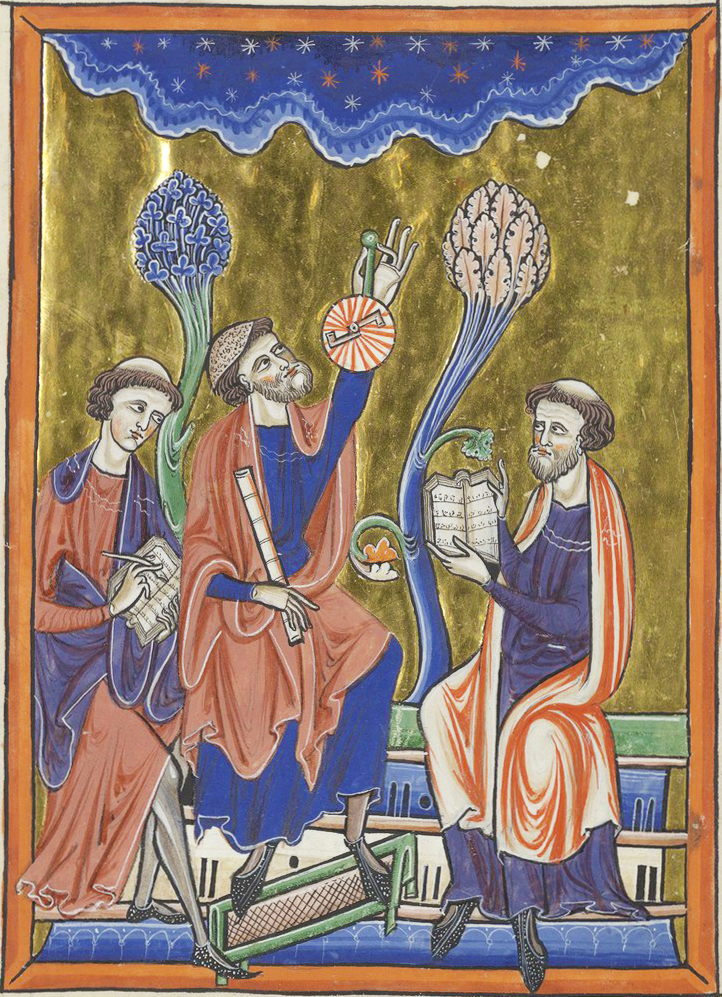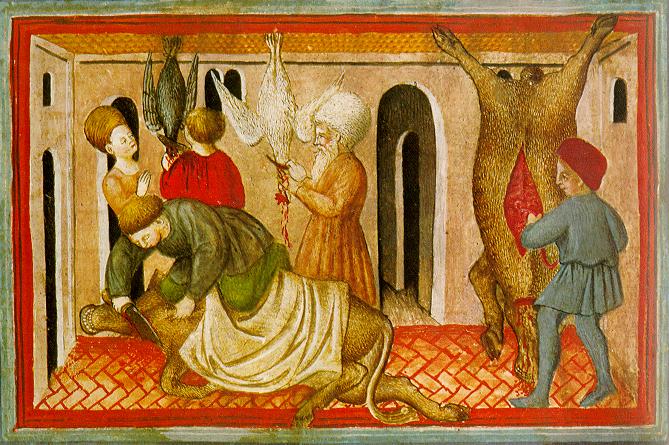|
Judah Ben Benjamin Anav
Rabbi Judah ben Benjamin Anav (Hebrew: יהודה בן בנימין ענו or ריבב"ן; approximately 1215-1280) was one of the Rishonim in Italy. He wrote a known commentary on the main book of Isaac Alfasi, a commentary to tractate Shekalim of the Mishna and on Sheiltot by Achai Gaon.Anav, Judah ben Benjamin Ha-Rofe '''' He also wrote a book about and |
Rishonim
''Rishonim'' (; he, ; sing. he, , ''Rishon'', "the first ones") were the leading rabbis and ''poskim'' who lived approximately during the 11th to 15th centuries, in the era before the writing of the ''Shulchan Aruch'' ( he, , "Set Table", a common printed code of Jewish law, 1563 CE) and following the ''Geonim'' (589-1038 CE). Rabbinic scholars subsequent to the ''Shulchan Aruch'' are generally known as ''acharonim'' ("the latter ones"). The distinction between the ''rishonim'' and the ''geonim'' is meaningful historically; in ''halakha'' (Jewish Law) the distinction is less important. According to a widely held view in Orthodox Judaism, the acharonim generally cannot dispute the rulings of rabbis of previous eras unless they find support from other rabbis in previous eras. On the other hand, this view is not formally a part of ''halakha'' itself, and according to some rabbis is a violation of the halakhic system.See Kesef Mishna (Maamrim 2:2), Kovetz Igros Chazon Ish (2:26) ... [...More Info...] [...Related Items...] OR: [Wikipedia] [Google] [Baidu] |
Isaac Alfasi
Isaac ben Jacob Alfasi ha-Cohen (1013–1103) ( ar, إسحاق الفاسي, he, ר' יצחק אלפסי) - also known as the Alfasi or by his Hebrew acronym Rif (Rabbi Isaac al-Fasi), was a Maghrebi Talmudist and posek (decider in matters of halakha - Jewish law). He is best known for his work of ''halakha'', the legal code Sefer Ha-halachot, considered the first fundamental work in ''halakhic'' literature. His name "Alfasi" means "of Fez" in Arabic, but opinions differ as to whether he ever lived in Fez. Biography He was born in Qalaat Hammad, which is understood by most historians of the past 100 years to be Qalaat Beni Hammad in modern-day Algeria, capital city of the Hammadid rulers of central Maghreb.Leonard Levy, ''R. Yitzhaq Alfasi's application of principles of adjudication in Halakhot Rabbati'', footnotes 11-27 However, older sources believe Qalaat Hammad refers to a village near Fez. In the former case, Alfasi's name would indicate that his family had ancestry in Fez, ... [...More Info...] [...Related Items...] OR: [Wikipedia] [Google] [Baidu] |
Shekalim
Shekel or sheqel ( akk, 𒅆𒅗𒇻 ''šiqlu'' or ''siqlu,'' he, שקל, plural he, שקלים or shekels, Phoenician: ) is an ancient Mesopotamian coin, usually of silver. A shekel was first a unit of weight—very roughly —and became currency in ancient Tyre and ancient Carthage and then in ancient Israel under the Maccabees. Name The word is based on the Semitic verbal root for "weighing" (''Š-Q-L''), cognate to the Akkadian or , a unit of weight equivalent to the Sumerian . Use of the word was first attested in during the Akkadian Empire under the reign of Naram-Sin, and later in in the Code of Hammurabi. The ''Š-Q-L'' root is found in the Hebrew words for "to weigh" (), "weight" () and "consideration" (). It is cognate to the Aramaic root ''T-Q-L'' and the Arabic ''root Θ-Q-L'' ''ثقل'', in words such as (the weight), (heavy) or (unit of weight). The famous writing on the wall in the Biblical Book of Daniel includes a cryptic use of the word in Aram ... [...More Info...] [...Related Items...] OR: [Wikipedia] [Google] [Baidu] |
Mishna
The Mishnah or the Mishna (; he, מִשְׁנָה, "study by repetition", from the verb ''shanah'' , or "to study and review", also "secondary") is the first major written collection of the Jewish oral traditions which is known as the Oral Torah. It is also the first major work of rabbinic literature. The Mishnah was redacted by Judah ha-Nasi probably in Beit Shearim or Sepphoris at the beginning of the 3rd century CE in a time when, according to the Talmud, the persecution of the Jews and the passage of time raised the possibility that the details of the oral traditions of the Pharisees from the Second Temple period (516 BCE – 70 CE) would be forgotten. Most of the Mishnah is written in Mishnaic Hebrew, but some parts are in Aramaic. The Mishnah consists of six orders (', singular ' ), each containing 7–12 tractates (', singular ' ; lit. "web"), 63 in total, and further subdivided into chapters and paragraphs. The word ''Mishnah'' can also indicate a single paragraph of ... [...More Info...] [...Related Items...] OR: [Wikipedia] [Google] [Baidu] |
Sheiltot
She'iltot of Rav Achai Gaon, also known as Sheiltot de-Rav Ahai, or simply She'iltot ( he, שאלתות), is a rabbinic halakhic work composed in the 8th-century by Ahai of Shabha (variants: Aḥa of Shabha; Acha of Shabcha), during the geonic period. ''She'iltot'' is an Aramaic word, meaning "Inquiries" or "Quæstiones" (in the sense of disquisitions) and is arranged in order of the biblical pericopes, or weekly Torah readings. The ''She'iltot'' is one of the earliest rabbinic works composed after the Talmud. Place of composition According to Abraham ibn Daud, Aḥai of Shabha completed his ''She'iltot'' between the years 741 and 763 CE, a timeframe corroborated by Sherira ben Hanina in his '' Iggeret''.Sherira Gaon (1988), p. 127 (Chapter 12: The Geonic Period) It is unclear whether he compiled his work in Palestine or in Lower Mesopotamia (called "Babylonia"), although it is without question that he moved from Babylonia to Palestine around the time that Natroi (Natronai) Kaha ... [...More Info...] [...Related Items...] OR: [Wikipedia] [Google] [Baidu] |
Achai Gaon
Achai Gaon (also known as Ahai of Shabḥa or Aha of Shabḥa, Hebrew: רב אחא �חאימשַׁבָּחָא) was a leading scholar during the period of the Geonim, an 8th-century Talmudist of high renown. He enjoys the distinction of being the first rabbinical author known to history after the completion of the Talmud. As he never actually became the Gaon of either of the two academies, the description "Gaon" attached to his name is a misnomer. When the gaon of Pumbedita died, Aḥa was universally acknowledged to be the fittest man to succeed him. But a personal grudge entertained by the exilarch Solomon bar Ḥasdai induced the latter to pass over Aḥa, and to appoint Natronai ben Nehemiah, Aḥa's secretary, a man considerably his inferior in learning and general acquirements. Angered by this slight, Aḥa left Babylonia and settled in Israel, about 752 or 753, where he remained until his death. Despite Steinschneider's erroneous assertion that he died in 761, the exact ... [...More Info...] [...Related Items...] OR: [Wikipedia] [Google] [Baidu] |
Encyclopaedia Judaica
The ''Encyclopaedia Judaica'' is a 22-volume English-language encyclopedia of the Jewish people, Judaism, and Israel. It covers diverse areas of the Jewish world and civilization, including Jewish history of all eras, culture, holidays, language, scripture, and religious teachings. As of 2010, it had been published in two editions accompanied by a few revisions. The English-language ''Judaica'' was also published on CD-ROM. The CD-ROM version has been enhanced by at least 100,000 hyperlinks and several other features, including videos, slide shows, maps, music and Hebrew pronunciations. While the CD-ROM version is still available, the publisher has discontinued it. The encyclopedia was written by Israeli, American and European professional subject specialists. History Preceding attempts Between 1901 and 1906 ''The Jewish Encyclopedia'' had been published in 12 volumes. It was followed by the ''Jüdisches Lexikon I–II'' (1927–28, in German), ''Encyclopaedia Judaica I–II ... [...More Info...] [...Related Items...] OR: [Wikipedia] [Google] [Baidu] |
Shechita
In Judaism, ''shechita'' (anglicized: ; he, ; ; also transliterated ''shehitah, shechitah, shehita'') is slaughtering of certain mammals and birds for food according to ''kashrut''. Sources states that sheep and cattle should be slaughtered "as I have instructed you", but nowhere in the Torah are any of the practices of ''shechita'' described. Instead, they have been handed down in Rabbinic Judaism's Oral Torah, and codified in ''halakha''. Species The animal must be of a permitted species. For mammals, this is restricted to ruminants which have split hooves. For birds, although biblically any species of bird not specifically excluded in would be permitted, doubts as to the identity and scope of the species on the biblical list led to rabbinical law permitting only birds with a tradition of being permissible. Fish do not require kosher slaughter to be considered kosher, but are subject to other laws found in which determine whether or not they are kosher (having both ... [...More Info...] [...Related Items...] OR: [Wikipedia] [Google] [Baidu] |
Terefah
Terefah ( he, טְרֵפָה, lit. "torn by a beast of prey"; plural ''treifot'') refers to either: * A member of a kosher species of mammal or bird, disqualified from being considered kosher, due to pre-existing mortal injuries or physical defects. * A specific list of mortal injuries or physical defects that disqualify a member of a kosher species of mammal or bird from being kosher. Biblical prohibition The biblical prohibition of eating ''terefah'' stems from the verse: According to the Talmud,Hullin 37a there were originally only eight types of terefah, however, the author(s) of the Mishnah added eighteen items to the list. Eventually, Maimonides added even more to finish the list of terefah conditions at 70. Rabbi Joseph Caro organized all of these symptoms in the Shulchan Aruch (Yoreh De'ah, 29-60) by categorizing them according to parts of the animal, their minute malady, and any disease, fracture, or abnormality they may possess.The Jewish Encyclopedia. Funk and Wagn ... [...More Info...] [...Related Items...] OR: [Wikipedia] [Google] [Baidu] |
Zedekiah Ben Abraham Anaw
Zedekiah ben Abraham Anaw (13th century; also known by the surname HaRofeh) was an author of halakhic works and younger brother of Benjamin ben Abraham Anaw. He lived at Rome and received his Talmudic training not only in Rome but also in Germany where he was the pupil of Jacob of Würzburg and possibly also of Abigdor Cohen of Vienna. ''Shibbolei haLeket'' He owes his reputation to his compilation of ritual law entitled ''Shibbolei haLeket'' (Ears of Gleaning). It is divided into 372 paragraphs, included in the following twelve sections, treating of the laws, regulations, and ceremonies relating to prayers, Sabbath, benedictions, new moon, Feast of Dedication, Purim, Passover, semi-holy days, fasts, New-year, Day of Atonement, and Sukkot. Appended to the work are several treatises and responsa on miscellaneous religious and legal matters, such as circumcision, mourning rites, tzitzit, shechita, inheritance, and interest. As the title indicates, and as the author never fails to po ... [...More Info...] [...Related Items...] OR: [Wikipedia] [Google] [Baidu] |



.jpg)
